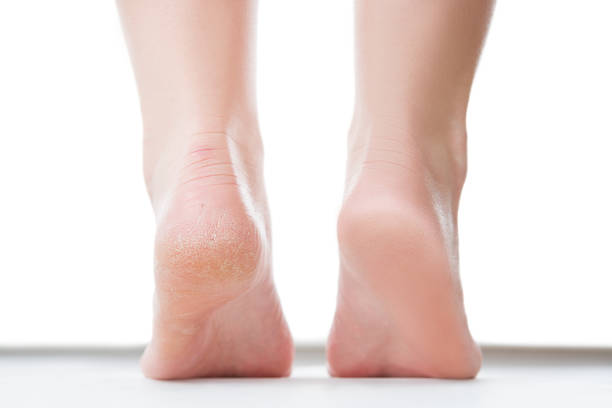Our potent Urea foot cream is the solution for your cracked heels, Get Pretty Feet Today!
You might expect to get chapped lips on a windy day and dry hands in winter, but your feet are at risk too, in all seasons and weather conditions.
Heel fissures, or dry ridges of cracked skin on the back and bottom of your heels, are a potentially painful condition that can sneak up on you, going from unsightly in sandals to downright debilitating in no time.

What Causes Cracked Heels?
You may not always think about checking your feet for dryness, but a little TLC to your extremities can go a long way to keeping the skin on your feet pretty, hydrated and strong.
Cracked heels start with dry skin, which turns sore, red, and swollen when you spend long periods standing, especially on hard, unpadded floors.
Other factors, like poorly-fitted shoes, cold weather, living in a hot and dry climate, walking barefoot, and wearing open-back shoes can bring it on.
There are also chronic conditions that make you a more likely candidate for excessive dryness and cracked heels, including diabetes, inactive sweat glands, athlete’s foot, obesity, hypothyroidism, eczema, and psoriasis.
When heel fissures appear, skin thickens and can turn yellow-brown around the edge of your heel.
If mild discomfort changes to pain, you’re likely to experience difficulty walking, bleeding, redness, and swelling, indicating an infection is present and it’s time to contact a healthcare professional.
But don’t toss your sandals in the back of the closet just yet.
Before dry feet lead to pain and medical bills, smooth them with Ebanel 40% Urea Cream on your heels to repair cracks, reduce callus build-up, and restore luster your feet, make your feet pretty and happy this summer.
Urea cream also can help other dry areas like hands, elbows, nails, and knees as well.
Why Urea Cream?

Urea is typically thought of as a waste product that is eliminated from the body in urine.
While your body doesn’t use urea internally, it’s an organic compound particularly well-suited for removing dead cells and promoting healing on the surface of your skin.
By softening the top layer of skin, urea increases your skin’s ability to retain moisture.
Salicylic acid and Urea, both skin-sloughing agents called keratolytics, work together to exfoliate and thin calluses that develop around heel fissures.
Urea 40 Rich Ingredients
Urea cream’s mixture of hypoallergenic ingredients work together to nourish and revive scaly, flaking skin. It’s vegan, non-comedogenic, and GMP-certified, and you won’t find sulfates, parabens, drying alcohol, fragrance, synthetic dyes, Triclosan, or other unsafe ingredients on the label.
What you will find are natural, organic ingredients like coconut oil to moisturize, reduce redness, and fight infection with its antimicrobial properties.
Anti-inflammatory aloe vera and Vitamins A and C contribute antioxidants, while non-greasy camellia provides an additional layer of moisturizing action.
Another natural anti-inflammatory, tea tree oil, soothes redness and swelling.
Use Urea Cream For Feet With Consistency

To keep your feet in barefoot-ready condition, you need to take care of them year-round.
While urea cream is a life-saver when it comes to restoring your feet to barefoot-ready condition, monitoring your feet for dryness and callous build-up is a year-round practice.
Take a proactive approach by devoting some time to caring for your feet, and other dry areas of your body like elbow and knees, on a daily basis.
Clean your skin and nails, then massage urea cream into dry areas two to three times a day for two to three weeks to treat cracked heels although if it's too cracked where blood shows, do not use the urea cream.
Once you’ve restored a healthy moisture barrier, use the cream regularly as needed to relieve dryness.
Add Urea Cream To Your Routine For Pretty Feet

Small changes to your skincare routine can help as well. Bathe with warm, not hot, water and keep baths and showers short to lessen skin moisture loss.
Use mild, fragrance-free cleansers and blot yourself dry to keep redness and irritation to a minimum.
Gentle use of a pumice stone on your heels can decrease the likelihood that skin will thicken and flake.
Always wash hands thoroughly after using urea cream as it can be irritating to eyes and other sensitive areas of your body.
How To Protect The Foot Skin?
getting shoes properly fitted and avoiding open-heeled shoes entirely.
Cotton socks are your best bet to reduce friction, absorb sweat, and allow your skin to breathe.
You can even wear socks to bed to keep moisture in and reduce friction against bedsheets.
Footwerar at home, use padded socks or non-slip shoes with a padded insert to protect the soft tissue on the bottom of your foot.
Your feet will thank you and you’re going to love the excuse for a relaxing foot massage.

